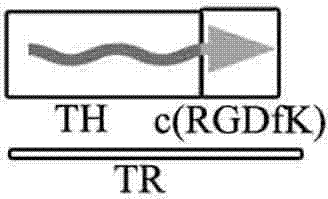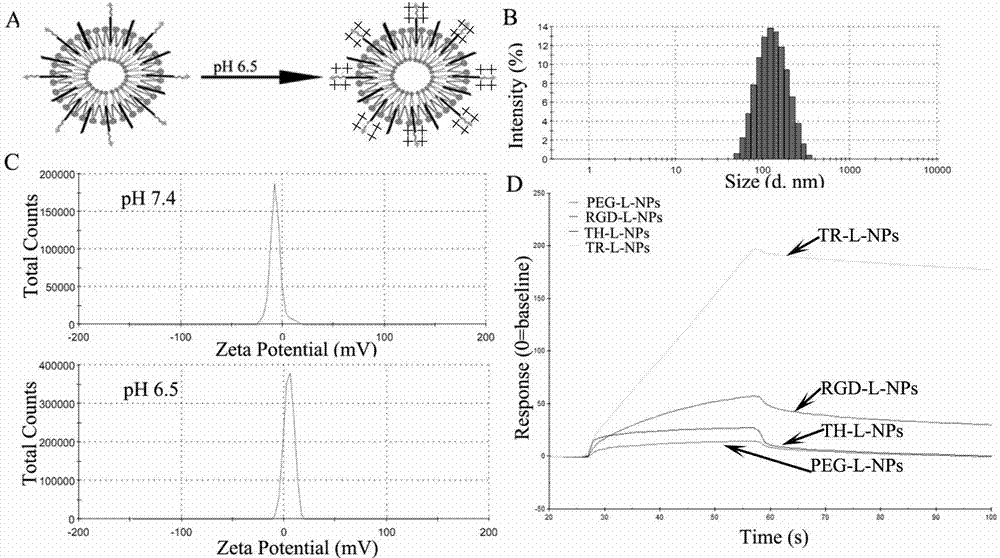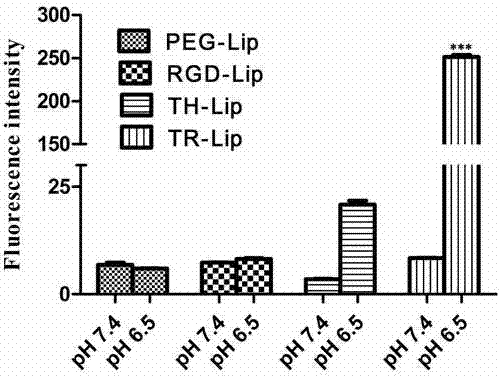Novel polypeptide with active tumor targeting and pH sensitive cell penetratingcapability
A sensitive and new technology, applied in anti-tumor drugs, peptides, hybrid peptides, etc., can solve problems such as side effects
- Summary
- Abstract
- Description
- Claims
- Application Information
AI Technical Summary
Problems solved by technology
Method used
Image
Examples
Embodiment 1
[0019] Preparation and characterization of TR peptide-modified liposomes (TR-Lip)
[0020] Liposomes were prepared by thin film dispersion method. Weigh 1.2 mg of soybean lecithin, 0.4 mg of cholesterol, 0.05 mg of monomethoxy-modified polyethylene glycol and 1 mg of TR peptide-modified polyethylene glycol, dissolve them all in chloroform / methanol mixture, rotate and evaporate , to form a thin film layer, which was placed in a vacuum desiccator overnight, so that the organic solvent was fully evaporated. Add 1 ml of Hepes buffer (pH 7.4), place it on a shaker (180 rpm × 30 min, 37 °C), shake it, and sonicate it with a sonicator (5 times × 5 s × 15 s) to obtain a uniform particle size. TR-Lip. Take 100 μl TR-Lip diluted 10 times, and measure its particle size distribution and charge distribution with Zetanano particle sizer. The particle size of TR-Lip is around 150 nm. At pH 7.4, the Zeta potential of TR-Lip was around -7 mV; at pH 6.5, the Zeta potential of TR-Lip was aro...
Embodiment 2
[0022] Preparation and characterization of TR peptide-modified nanoparticles (TR-NPs)
[0023] The TR peptide-modified nanoparticles were prepared by W / O / W emulsification-solvent evaporation method. A certain amount of PLA-PLL-TR was dissolved in dichloromethane to form an organic phase, pure water was used as the water phase, the organic phase and the water phase were mixed in a certain proportion, and colostrum was formed by ultrasonication. Pour the colostrum into the outer water phase containing Poloxamer F-18 emulsifier, continue to sonicate to obtain a re-emulsion and place it in a beaker, and stir to evaporate the organic solvent to obtain a nanoparticle colloidal dispersion system. The particle size distribution and charge distribution were measured by Zetanano particle size analyzer; the binding force with integrin was measured by SPR analyzer. The particle size of TR-NPs is about 90 nm. At pH 7.4, the Zeta potential of TR-NPs was around -7.5 mV; at pH 6.5, the Zeta...
Embodiment 3
[0025] Preparation and characterization of TR peptide-modified micelles (TR-micelle)
[0026]Dissolve 10 mg DSPE-PEG-TR and 20 mg DSPE-PEG-OMe in anhydrous chloroform respectively, form a film by rotary evaporation, dry under reduced pressure overnight, add 5 ml of 20 mM Hepes buffer (pH 7.4), and shake in a water bath at 37 °C. After 20 min, filtered with a 0.22 μm microporous membrane to obtain TR peptide-modified polymer micelles (TR-micelle). The particle size distribution and charge distribution were measured by Zetanano particle size analyzer; the binding force with integrin was measured by SPR analyzer. The particle size of TR-micelle is about 112 nm. At pH 7.4, the Zeta potential of TR-micelle was around -8 mV; at pH 6.5, the Zeta potential of TR-micelle was around +4 mV. Surface plasmon resonance (SPR) was used to measure the binding ability of micelles modified with different polypeptides to integrin, and TR-micelle had the strongest binding ability to integrin.
PUM
| Property | Measurement | Unit |
|---|---|---|
| particle diameter | aaaaa | aaaaa |
| particle diameter | aaaaa | aaaaa |
| particle diameter | aaaaa | aaaaa |
Abstract
Description
Claims
Application Information
 Login to View More
Login to View More - R&D
- Intellectual Property
- Life Sciences
- Materials
- Tech Scout
- Unparalleled Data Quality
- Higher Quality Content
- 60% Fewer Hallucinations
Browse by: Latest US Patents, China's latest patents, Technical Efficacy Thesaurus, Application Domain, Technology Topic, Popular Technical Reports.
© 2025 PatSnap. All rights reserved.Legal|Privacy policy|Modern Slavery Act Transparency Statement|Sitemap|About US| Contact US: help@patsnap.com



